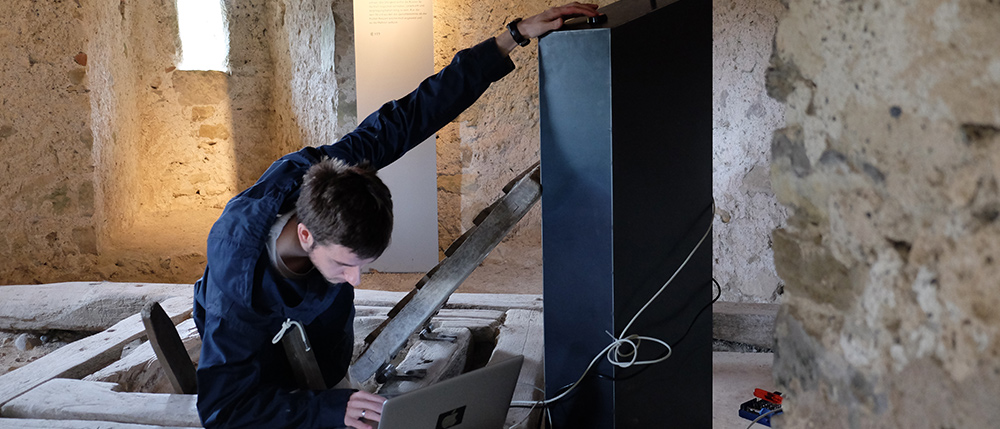Sound - Alive and Responsive
Generative / Interactive Audio
Generative sound design and composition techniques take a step away from the traditional playback of ambient sound and allow the creation of vivid sonic environments that can react and adapt to the visual content of a space as well as visitor interaction. In our work, these environments combine local sonic feedback with responsive ambient sound.
In an open air installation of 2016s Ganz Ohr project, located in the garden of a monastery, visitors could manipulate a clock whose internal mechanics were simulated by a transducer built into the interface. The surrounding multichannel ambient system would then react to different clock pointer positions with artistic reinterpretations of daily routines of the historic site’s former inhabitants.
One area of this year’s Museum of the Future contained a similar format of visitor surveys and result visualisation. However, here the ambient sound was an orchestral composition. Interaction sound originating from local interfaces therefore had to represent immediate user interaction as well as seamlessly blend into a fixed musical grid both rhythmically and harmonically. To achieve this, sonic events were combinations of several layers with different sonic content and purpose. Impulses synced with button presses would represent user interaction. Their decay would then morph into sonic clouds moving away from the local station into the ambient system, where they would eventually culminate in orchestral musical events on a synced grid.
The generative audio concept of the Media World exhibition in Luzern’s Verkehrshaus takes a different approach. Here, the ambient sound is not influenced by discrete actions of individual visitors, but rather by general behavioural information extracted from multiple points across the exhibition space. This includes amount of visitors present, frequency of interactions across the museum and amount of media content created by the visitors themselves. With this information the audio system consequently determines meta parameters such as musical tension, rhythmical density and overall intensity of the sonic experience.
Moving the clock pointer lets the visitor experience artistic reinterpretations of the daily routine in the monastery. This particular excerpt contains garden work, the Angelus prayer, silent prayer and sounds from the monastery’s historic church bell. Transitions between the soundscapes are signalled by various bells, as well as changes in the internal mechanics of the clock. Project: Ganz Ohr
The Shelter area of the Museum of Future Government Services 2017 lets visitors build their own futuristic city. ‚City Kits’ are dropped on the landscape and organically grow into urban structures. The growth process is locally sonified with layers of naturalistic sounds, while harmonic layers triggered at the stations consequently move into the ambient system to blend with the music.
Project: Museum of the Future 2017




